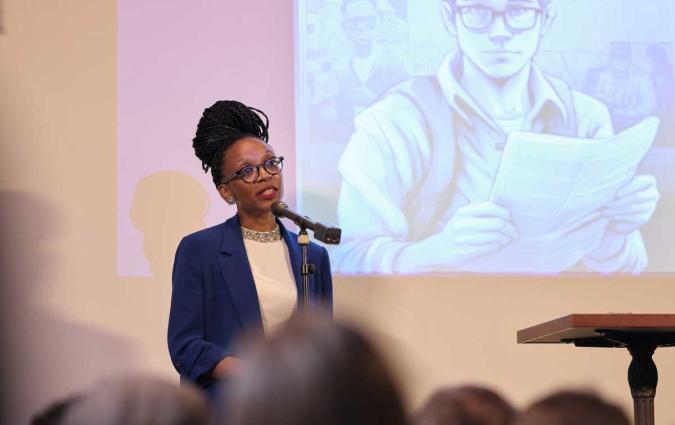In this piece
Navigating intergenerational dynamics at work: a study of Singaporean newsrooms

When the political editor of Lianhe Zaobao surveyed journalists and supervisors at five SPH Media newspapers, she found striking differences between what journalist say they want and what supervisors think they need. Illustration generated by DALL-E.
In this piece
The questionnaire | Finding one: journalists don't define job satisfaction in the way their supervisors expect them to | Finding two: journalists think their supervisors' demands are reasonable | Finding three: journalists and supervisors have different ideas around what motivates works | Finding four: journalists and supervisors identified the same tensions | SolutionsBetween 2011 and 2015, back when journalists "working from home" was almost unheard of, duty editors of Singapore’s Chinese language daily, Lianhe Zaobao (where I work), had to wait patiently till 2am for the paper to be off stone.
A group of mid-level editors and senior journalists – each with over a decade of service – would head up to the rooftop of our office after completing our work on Thursdays, creating a space to share our weal and woe.
While we never intended these rooftop sessions to become an exclusive "in-group" activity, the predominantly older composition of the group raised concern among some executives. In the end, an adjustment to our off-stone time put a halt to these sessions. But my awareness of concerns about creating divisions between age groups never went away.
Fast-forward eight years, and dynamics in newsrooms around the world have shifted with the entrance of Gen Z and the exit of many Boomers.
During my fellowship at the Reuters Institute, I spoke with many foreign journalists and read research confirming that intergenerational tensions are a common issue. But I wanted a clearer picture of what was happening in my own news company.
The questionnaire
To assess whether Singaporean newsrooms were experiencing intergenerational tensions, I created a questionnaire and distributed it to 25 young journalists (including Millennials and Gen Z) and 24 older supervisors (including Millennials and Gen X) at Lianhe Zaobao, The Straits Times, The Business Times, Shin Min Daily News and Berita Harian, five newspapers owned by the SPH Media Trust.
As a control, I also sent the questionnaire to seven people who have left the newsroom.
The respondents represent about 5% of SPH’s 1,000 editorial staff – not a representative sample size – but the findings were illustrative of some surprising gaps and instructive of what might be done to bridge them.
Finding one: journalists don't define job satisfaction in the way their supervisors expect them to
I asked my journalist respondents to rank a list of factors contributing to their job satisfaction from one to eight. I asked supervisors to rank the same factors, but according to what they thought younger journalists would want.
Half of the journalists said "doing meaningful work" was the most important aspect of satisfaction. By comparison, the largest proportion of supervisors thought young reporters would pick “work-life balance”. In fact, only one young journalist said work-life balance was of utmost importance.
Finding two: journalists think their supervisors' demands are reasonable
I asked journalists if they thought their supervisors’ work demands were reasonable, and asked supervisors what they thought the journalists would say.
Among young journalists, 80% thought their supervisors’ expectations of them were reasonable. This surpassed what the supervisors expected young journalists to say.
Even among former colleagues in the control group, only one thought his supervisor didn’t know how much was on his plate.
Finding three: journalists and supervisors have different ideas around what motivates works
Another key discrepancy between young journalists and their supervisors’ perception was around what motivates them at work: particularly among the younger respondents.
A subset of the youngest journalists said they are best motivated by mentoring; this was followed by a pay raise. That was not what the supervisors were expecting: only 8% thought pay would be a motivator.
Journalists also valued informal feedback and some formal feedback, but supervisors did not mention formal feedback at all.
Finding four: journalists and supervisors identified the same tensions
The questionnaire also dealt with the issue at the heart of my inquiry: are there intergenerational tensions in the newsroom? Most supervisors and journalists thought there are tensions, and they had similar views on reasons behind these tensions.
The topmost concern was a lack of communication. Most of the respondents also thought digitalisation has exacerbated tensions. With digitalisation, supervisors are themselves learning and adapting, and may not be proficient enough to provide effective supervision.
Meanwhile, younger journalists emphasised that journalism is very different now compared to what it was 20 years ago: it has to be seen in the light of reporters now facing a 24/7 news cycle.
Solutions
One senior editor said management should have more formal and informal interactions with reporters: hear their voices, answer and clarify questions, while a millennial supervisor suggested internal newsletters, “weekly communication time" between leaders and journalists.
Statistics also point to the usefulness of having more informal sessions. It is perhaps time to bring back rooftop get-togethers. But they will need to be a bottom-up, inclusive initiative: bridging the gap between young and old –even putting senior management in the hot seat at times to answer questions from the younger generation.
The younger generation is less likely than the old to stay with one employer for a lifetime. That means we need to make concerted efforts to connect new entrants to the organisation with the top and empower younger journalists to bring ideas to the top and leave an impression.
Lianhe Zaobao’s series of audience engagement and community outreach programmes create opportunities for senior and junior staff to form bridges.
The intergenerational tensions explored in this project are not unique to SPH Media – or even to Singapore. The full project (available to download as a PDF below) includes lessons from Malaysia and Taiwan, where media houses have also faced challenges associated with digitalisation.
More work remains to be done to better understand and remedy intergenerational tensions. But any media organisation that looks to engage in this conversation instead of shying away from it will reap the benefits of a newsroom that can bring together – not put aside – their differences to best serve evolving audience needs.


